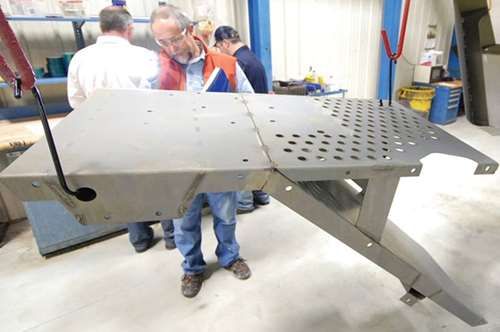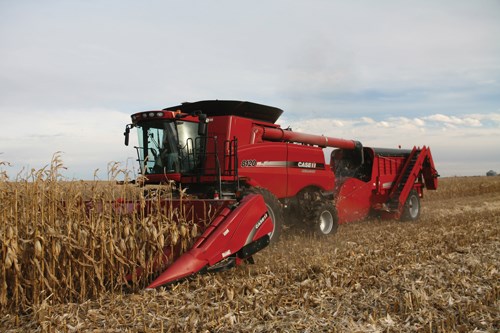The tractors and wheel loaders built at CNH Global N.V.’s plant in Fargo, N.D., always leave the factory with a bright finish.
But paint crew manufacturing engineer Billy McKeown, manufacturing manager Billy Moser and general supervisor of paint Al Hogenson know that after a few days of rugged use in the field amidst the mud, dirt, rain and other weapons Mother Nature can throw at it, the finish might not be as shiny. Case IH’s trademark red coating will be there for a long time, however, thanks to a recent upgrade in the plant’s pretreatment system.
Case IH is one brand of CNH, a world leader in the agricultural and construction equipment businesses. Created in 1999 through the business merger of New Holland and Case Corp., CNH today comprises the agricultural and construction brands Case IH, New Holland, Steyr and Kobelco, which has more than 11,300 dealers in nearly 170 countries, as well as 37 manufacturing facilities.
In 2011, McKeown, Moser and Hogensen re-engineered the paint line’s pretreatment system to improve its performance and reduce costs, a process that took nearly two years and numerous trials before they were able to find just the right fit.
SLUDGE BUILDUP
“We had a lot of sludge in our Stage 3 deoxidizing stage, which we were using for laser edge removal,” McKeown says. “The iron and phosphate in the bath was turning to sludge, and clogging up nozzles and piping—you name it.”
CNH wanted to eliminate pre-phosphating, which is an incomplete iron phosphate reaction that causes poor corrosion performance in the field.
After re-engineering the line through a change in chemistries, the sludge has been reduced and the line has improved efficiency. The result: nearly $349,000 in savings the first year and an improved pretreatment process that does away with phosphoric deoxidizing in favor of a sulfuric-based technology that eliminates iron and phosphate sludge.
The improved process cleans off not only laser scale, but also weld smoke and weld scale, which is an increasing issue with many manufacturing processes. Removing the scale and oxide with chemical eliminates a lot of manual labor and shop time.
“We could see the change right away the first few times we ran the line, even during testing,” McKeown says. “From a visual standpoint, it was a better cleaning process. The improved cleaning eliminated streaking and flash rust that was an issue causing rework. Operationally, the entire line runs and works so much better.”
EIGHT-STAGE PRETREATMENT
Case IH’s previous eight-stage pretreatment consisted of an alkaline cleaner, rinse, acid pickle/phosphoric acid bath, a neutralizer and two reverse osmosis (RO) rinses, followed by a pretreatment and another RO rinse.
What McKeown was seeing before that change was sludge buildup in the cleaning nozzles, which would cause line stops, inconsistent coatings and flash rust, high labor costs in the maintenance of the washer, and excessive waste treatment chemical costs.
McKeown tried working with his supplier, but then began discussions with other vendors to help troubleshoot his line and improve efficiencies. Chemetall’s Ladd Ojala began working with Case IH in 2009, designing a new system and performing a series of tests to confirm performance gains and process parameters.
- Eliminate excessive sludge generation of the previous supplier’s deox.
- Eliminate numerous line stops because of sludge.
- Significantly reduce sludge-removal cost.
- Reduce waste treatment chemical usage by eliminating phosphate.
- Improve maintenance of the washer.
BETTER PROCESS COSTS
“We used a similar line configuration as the previous supplier, but we saw improved chemistries that enhanced edge scale removal and had virtually no sludging,” Ojala says. “On top of that, we saw a better process cost optimization and an overall improved appearance of parts.”
Ojala brought out his best weapons for Case IH: Pyrene 1021 oil-splitting cleaner, Acid Clean 969 no-sludging laser and weld deox, GL 4430 U neutralizing rinse and rust inhibitor, ChemCote 3010 ambient-temperature advanced phosphate, and Tech Seal 38645 technology silane-zirconium rinse.
Essentially, the change for Case IH meant better cleaning, scale removal without flash rust, a more uniform coating, and significant improvement in salt spray tests.
“Paint failures often start first on a weld that is not cleaned well,” Ojala says. “The industry is looking into this more and more and wants to address the smut issue in process because it saves labor and time of a manual grinding process.”
Indeed, it was something McKeown really wanted to take care of when he re-engineered the line.
FIXING WELD AREAS
“Those weld areas are one of the first places you can have some premature corrosion,” he says. “And when it comes to the laser edges, if it’s not cleaned right and treated, then the paint can start chipping off. We really wanted to make sure we had a good adhesion in those areas.”
Overall, the process cost optimization was roughly $349,000 as Case IH saved on sludge removal, waste water treatment chemicals, washer maintenance parts, electric and gas, consumables and other expenses.
Specific changes in the washer included replacing the nozzle system in Stages 1-4, which improved cleaning and rinsing, and provided better laser/weld scale removal, resulting in a more uniform coating.
Ojala also helped with counter-flow rinses and plumbing modifications that enabled Case IH to conserve water, extend bath life and reduce costs.
The project did require Case IH to re-plumb the existing Stage 3 filter to Stage 4, but that resulted in a conservation of water and improved part quality and appearance.
Chemetall used an ambient-temperature pretreatment at the Case IH plant that achieved $40,000 in cost reduction in Stage 6. In Stage 3, energy reduction was significant, as was the elimination of the phosphoric deox that reduced the waste treatment chemical spend by $30,000.
REDUCING SLUDGE
More important to keeping McKeown’s paint line moving, the number of tote bags of sludge removed from the waste treatment went from 12 a month to just four.
Before the re-engineered line went live in August 2011, Chemetall trained all Case IH line personnel on quality monitoring, lab analysis and performance testing. Ojala works closely with McKeown and his team on continuous improvement through line audits, and safety and health reviews, as well as ongoing productivity and cost-reduction programs.
“It’s been a great transformation for us,” McKeown says. “We really haven’t seen any issues with the change. The sludge is gone, and, although that was really important to get that taken care of, the other benefits in the cost savings have been great, too.”
RELATED CONTENT
-
Tips to Avoid Pressure Drop in Air Spraying
-
If you are performing a coating process that requires the use of a rectifier, you may have experienced the "no amperage" problem. Here's a look at the phenomenon and some solutions…
-
Masking is employed in most any metal finishing operation where only a specifically defined area of the surface of a part must be exposed to a process. Conversely, masking may be employed on a surface where treatment is either not required or must be avoided. This article covers the many aspects of masking for metal finishing, including applications, methods and the various types of masking employed.


















